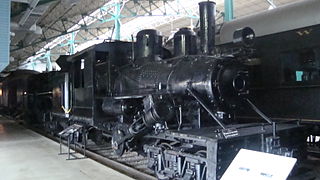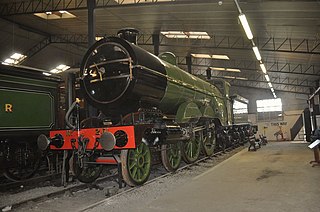Related Research Articles

A rack railway is a steep grade railway with a toothed rack rail, usually between the running rails. The trains are fitted with one or more cog wheels or pinions that mesh with this rack rail. This allows the trains to operate on steep grades above 10%, which is the maximum for friction-based rail. Most rack railways are mountain railways, although a few are transit railways or tramways built to overcome a steep gradient in an urban environment.

A boiler is a closed vessel in which fluid is heated. The fluid does not necessarily boil. The heated or vaporized fluid exits the boiler for use in various processes or heating applications, including water heating, central heating, boiler-based power generation, cooking, and sanitation.

A steam locomotive is a locomotive that provides the force to move itself and other vehicles by means of the expansion of steam. It is fuelled by burning combustible material to heat water in the locomotive's boiler to the point where it becomes gaseous and its volume increases 1,700 times. Functionally, it is a steam engine on wheels.

A Climax locomotive is a type of geared steam locomotive built by the Climax Manufacturing Company, of Corry, Pennsylvania. These had two steam cylinders attached to a transmission located under the center of the boiler, which sent power to driveshafts running to the front and rear trucks. Some 1000-1100 were built in three classes - A, B, and C - between 1888 and 1928.

The Willamette locomotive was a geared steam locomotive of the Shay locomotive type, built by the Willamette Iron and Steel Works of Portland, Oregon. After key patents on the Shay locomotive had expired, it was possible for other manufacturers to produce Shay-like locomotive designs.

Marathon Motor Works was a brass era automobile manufacturer based in Tennessee. Southern Engine and Boiler Works founded in 1889, which made industrial engines and boilers in Jackson, Tennessee, established the factory in 1907. From 1909 to 1914, the company manufactured the Marathon automobile in Nashville, Tennessee.

USS Anthony (DD-172) was a Wickes-class destroyer built for the United States Navy during World War I.

Daniel Adamson was an English engineer who became a successful manufacturer of boilers and was the driving force behind the inception of the Manchester Ship Canal project during the 1880s.

The Great Northern Railway (GNR) Small Boiler Class C1 is a class of steam locomotive, the first 4-4-2 or Atlantic type in Great Britain. They were designed by Henry Ivatt in 1897. In total 22 were built between 1898 and 1903 at Doncaster Works. The class were commonly known as 'Klondykes' [sic], after the 1897 Klondike gold rush. They could reach speeds of up to 90 mph. They were also known as Small Atlantics.

The NZR K class of 1877 was the first example of American-built locomotives to be used on New Zealand's rail network. Their success coloured locomotive development in New Zealand until the end of steam.

Light Vessel Number 83 (LV-83) Swiftsure is a lightship and museum ship owned by Northwest Seaport in Seattle, Washington. Launched in 1904 at Camden, New Jersey and in active service until 1960 after serving on all five of the American west coast's lightship stations, it is the oldest surviving lightship in the United States, the only one still fitted with its original steam engine, and the last lightship with wooden decks. LV-83 was designated a National Historic Landmark in 1989, and has been undergoing major restoration since 2008.

The LNER W1 No. 10000 was an experimental steam locomotive fitted with a high pressure water-tube boiler. Nigel Gresley was impressed by the results of using high-pressure steam in marine applications and so in 1924 he approached Harold Yarrow of shipyard and boilermakers Yarrow & Company of Glasgow to design a suitable boiler for a railway locomotive, based on Yarrow's design.

The GS&WR Class 101, classified as Class 101 or Class J15 by the Great Southern Railways, was a class of 0-6-0 steam locomotives designed for working goods traffic although they did, and were quite capable of, working branch and secondary passenger trains.

The Great Northern Railway (GNR) Class C1 is a type of 4-4-2 steam locomotive. One, ex GNR 251, later LNER 2800, survives in preservation. Much like their small boiler cousins, they were capable of reaching speeds of up to 90 mph (145 km/h). They were also known as Large Atlantics.

The London and North Eastern Railway (LNER) Class K1 is a type of 2-6-0 (mogul) steam locomotive designed by Edward Thompson. Thompson preferred a simple two-cylinder design instead of his predecessor Nigel Gresley's three-cylinder one. The seventy K1s were intended to be split between the North Eastern Region of British Railways and the Eastern Region of British Railways.

A "Scotch" marine boiler is a design of steam boiler best known for its use on ships.

The NER Class R1 was a class of 4-4-0 steam locomotives of the North Eastern Railway. The class was designed by Wilson Worsdell and built from 1908 to 1909.

The Norman was a bulk freighter; its wreck in Lake Huron was listed on the National Register of Historic Places in 2016.

Edward Daniel Meier was an American mechanical engineer, and President and chief engineer of the Heine Safety Boiler Company, known as president of the American Society of Mechanical Engineers in the year 1911–12.
References
- ↑ "Boiler Works". 26 April 2016. Archived from the original on 15 August 2020. Retrieved 19 May 2020.